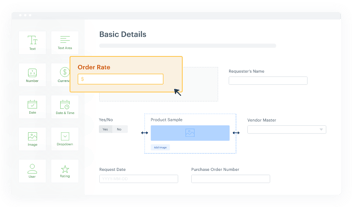
- >
- Workflow platform>
- The definitive guide to approval processes
The Definitive Guide to Approval Processes
Your approval processes are killing your productivity. While you're waiting days or weeks for simple approvals to work their way through your organization, your competitors are making decisions in minutes with automated approval workflows. Every delayed approval is a missed opportunity, frustrated employee, and dissatisfied customer walking out the door.
The reality check is brutal: over 40% of finance professionals and 33% of accounting professionals say automating purchasing and procurement processes is a top priority, yet only 4% of businesses have fully automated their workflows. Meanwhile, roughly 44% of procurement decision-makers say efficiency and complexity are primary challenges for their procurement processes. Your manual approval bottlenecks are exactly what's holding you back.
Here's what forward-thinking organizations already know: businesses using BPA report cost reductions between 10% and 50%, and organizations implementing RPA have seen ROI improvements ranging from 30% to 200% within the first year of deployment. The global BPA market is projected to grow from $13 billion in 2024 to $23.9 billion by 2029—a clear signal that automation isn't optional anymore, it's survival.
The window for competitive advantage is shrinking fast. More than 80% of companies plan to keep or grow their investment in automation solutions, and most businesses recover their automation investment within 2-4 weeks. Every day you operate with manual approval processes is another day your competitors pull further ahead.
What is an approval process?
An approval process is a structured workflow system that defines the sequential steps, authorization levels, and decision-making hierarchy required to formally review, approve, or reject business requests, documents, or transactions within an organization.
This systematic approach ensures proper governance, compliance, and accountability by routing submissions through designated approvers based on predefined criteria such as monetary thresholds, department authority, or risk levels. Modern approval processes leverage automation technology to eliminate manual bottlenecks, reduce processing time from days to minutes, and provide real-time visibility into request status and decision-making workflows.

Key components of an approval process:
-
Request Submission: Initial input of documents or requests requiring authorization
-
Routing Logic: Automated assignment to appropriate approvers based on business rules
-
Authorization Levels: Hierarchical permission structures defining decision-making authority
-
Workflow Tracking: Real-time visibility into approval status and processing stages
-
Audit Trail: Complete documentation of all approval decisions and actions
-
Notification System: Automated alerts and reminders to prevent delays
What is an approval system?
An approval system is a comprehensive technology platform that automates and streamlines approval workflows within an organization. Unlike manual approval processes that rely on email chains and physical document routing, an approval system provides centralized request management, automated decision routing, real-time status tracking, and integrated communication tools.
These systems reduce approval cycle times by up to 75% while ensuring consistent application of business rules and maintaining complete audit trails for compliance requirements.
-> Learn more about how to create approval workflows in 15 mins
What is approval management?
Approval management is the process component of a workflow that requires an approver (or supervisor) to authenticate and approve a step or task to push the request along the defined path. Approval management is key to ensuring increased transparency and accountability.
What are the various approval process elements?
A standard approval process has the following 5 elements. They are,
1. Submission documents
The submission documents can be anything that needs approval, whether an invoice, a purchase quote, or any other internal document. A well-defined document approval process ensures that every submission follows a structured workflow for review and authorization.
The process is especially crucial for the approval of a document or policy, ensuring compliance and accuracy before implementation.
2. Approvers
The approvers decide whether the submitted documents should be approved or rejected. If your process has various levels of approval, it’s important to decide who approves the documents first.
A document approval process often involves multiple stakeholders, ensuring accountability and adherence to company policies.
3. Permission levels
To ensure security within the organization, it is essential to establish varying permission levels for each user. These levels allow you to manage who can view, edit, reject, or approve submitted documents.
When managing the approval of a document or policy, permission settings ensure that only authorized personnel can make changes or grant final approval, reducing the risk of errors and unauthorized modifications.
4. Due dates
Just like any other business process, approval processes should also have set deadlines so that they can be initiated and completed in a timely manner.
5. Logs
Recording every step of the approval process is just as important not only to maintain transparency throughout the organisation, but also to easily view and track all the actions in case of a discrepancy.
4 examples of approval processes
With the right approval processes in place, you can quickly review each deliverable and get approvals more quickly. The type of approval process you create will depend on the deliverables and the departments you are dealing with.
Let’s take a look at 4 approval process examples:
1. Invoices Approvals
Before approving an invoice, the accounting department needs to verify a series of parameters. In this case, the approval process can have a checklist that can be used to make sure all the necessary parameters including invoice number, price, date, and payment terms are reviewed before the invoice is cleared.
The form may go through a workflow including the purchasing, finance, and those actually receiving the goods or services.
2. Budget Approvals
Managing operational budgets are an important part of the company's function. Once the budget proposal is completed, it needs to be vetted by a series of executives before being accepted and implemented.
A budget approval involves passing the budget through various filters, departments, and approvers, making the appropriate changes, and ensuring the budget aligns with the objectives and demands of the organization.
3. Design Approvals
Design is probably the first thing customers notice when interacting with a brand. Marketing teams need to ensure their logos, graphics, ads, merchandise, and everything else is designed and packaged properly in accordance to the design standards and guidelines. A design approval encapsulates every stage a design goes through from initial drafting, change management, brand scrutiny, marketing approvals, and final management vetting.
This is a sophisticated process since every iteration requires the graphic designer to rework the product and reinitiate approvals.
4. Creative approvals
As compared to invoice approvals, creative approvals have a more complicated process. For instance, you may need multiple steps to include content writing, graphic designers, and web technicians, each with conditional approvals after the work is completed.
This guide on Power Automate provides insight into automating multi-step approval workflows effectively.
Built for teams of all sizes, these workflow automation tools drive efficiency.
Workflows might also be dependent on:
-
The number of revisions that can be requested
-
The time limit on the revision period
-
The number of days it would take to deliver the designs
With these approval parameters in place, the designers can be assured that their workload won’t suddenly grow and they also wouldn’t have to worry about client responsiveness.
Benefits of automating your approval process
Manual approval processes take a longer time to complete and they are also more prone to errors. On the other hand, automating approval processes can give you more control, transparency, and allow your team members to get approvals quickly.

4 Key Benefits of automating approval processes are:
1. Custom templates:
With built-in templates, you can easily create new workflows for the approval process by customizing those templates instead of designing one from scratch. This, in turn, allows you to save time and kickstart the approval process faster.
2. Editing capabilities:
Once you have created a workflow for an approval process and you start using it, there might be some changes required to the parameters or the procedures that were initially in place. You can easily edit an existing automated approval process instead of creating a new one.
3. Better compliance and security:
By automating approval processes, you are able to record every step of the process which can then be easily reviewed to check for compliances during internal audits.
You are also able to maintain tighter security across the organisation, by only giving access to the approval documents to users who are involved in the process.
4. Seamless collaboration:
For complex approval projects, monitoring every member’s actions and ensuring a proper flow of information can be an incredibly tedious task.
Keeping track of the different levels of the approval process, updating different users involved, and adhering to deadlines can become a whole lot easier when the processes are automated.
How to use approval for request management?
Approvals play an integral role in request management - by adding a layer of approval, decision-makers can keep an eye on quality as well as take contextual decisions on whether the request meets certain criteria, thereby triggering the request to go forward along the workflow path or backwards for additional action.
How to create an approval process in Kissflow easily
Kissflow is a cloud-based business process and workflow management tool that can help you automate approval processes in your organization in less than 15 minutes.
It’s a no-code application with intuitive drag and drop tools that allow you to automate workflows in the easiest way possible. It also offers heightened data security with role-based access, which means you can control who has access to the data.
You can create automated approval processes in Kissflow in just three steps:
Step 1: Set up a form
The first step is to create a form that includes all the parameters of your approval process. Kissflow Workflow allows users to add custom fields for attaching files, auto-populating data, tables, and much more.
Step 2: Create a workflow
The next step is to create a workflow for the approval process. This can be as simple as a one-step process that only involves your team manager, or it can include multiple levels of approval from different departments within the organization.
Step 3: Add approvers and submitters
The final step is to add all the people involved in the approval process so that they can submit, view, approve or reject documents. At this step, you can also decide which users are allowed to edit and modify the data.
Conclusion
Workflow Approval Processes are a part of every organization’s day-to-day agenda, and by automating them through workflow management tools like Kissflow you can increase the productivity and efficiency of your team while seamlessly managing every process.
Try Kissflow Workflow Management Software for free today to customize and automate approval processes for your team easily.
Solve your workflow challenges with Kissflow platform and optimize your team's productivity.
Automate Approval Processes for Your Team Easily
Frequently Asked Questions
1. What is an approval system?
An approval system is a structured process that helps organizations manage and streamline approvals within workflows. It ensures that tasks, documents, budgets, and requests go through a standardized workflow approval process, reducing delays and improving accountability.
Kissflow’s approval management software automates this process, allowing businesses to set up multi-level approvals, role-based access, and real-time tracking for efficient decision-making.
2. What are the steps of the approval process?
The approval process workflow typically includes six key steps: (1) Submission, where a request is initiated, (2) Review, where details are verified, (3) Approval Routing, which directs the request through predefined stages, (4) Decision Making, where approvers accept, reject, or request modifications, (5) Revisions, if changes are needed, and (6) Final Approval & Execution, where the request is completed.
Kissflow automates these steps, ensuring smooth processing with minimal manual intervention.
3. What is approval process flow?
The approval process flow defines how a request moves through different stages until final approval. It includes defining roles, setting rules for routing approvals, and tracking progress. In Kissflow, businesses can create dynamic, automated workflows that eliminate bottlenecks, enhance collaboration, and ensure compliance.
Features like real-time notifications, audit trails, and customizable approval paths make the process more efficient and error-free.
4. What is type approval process?
The type approval process is a structured approach to ensuring compliance before approving documents, financial transactions, or operational workflows. Common types include the document approval process for policies and contracts, payment approval processes for invoices and expenses, budget approvals for financial planning, and procurement approvals for vendor transactions.
Kissflow enables organizations to automate these processes, ensuring faster approvals, improved compliance, and seamless workflow execution.
5. What are the key steps in an approval process?
Key steps in an approval process include request submission with required information, initial validation checking completeness, routing to appropriate approvers based on business rules, notification of pending approvals, reviewer evaluation against established criteria, approval/rejection with documented reasons, notification of decision to requesters, and record-keeping for audit purposes. Well-designed approval processes include escalation paths for delays.
6. How does automation improve approval workflows?
Automation improves approval workflows by routing requests to appropriate approvers based on content and rules, automatically checking for completeness and validation, sending reminders for pending items, escalating delays to maintain service levels, providing mobile access for on-the-go approvals, maintaining comprehensive audit trails, and enabling parallel approvals when multiple stakeholders can review simultaneously.
7. What industries require robust approval workflows?
Industries requiring robust approval workflows include financial services (loan underwriting, investment decisions), pharmaceutical companies (clinical trials, regulatory submissions), government agencies (permit issuance, grant approvals), healthcare (insurance authorizations, medical procedures), and manufacturing (engineering changes, quality exceptions). These sectors face significant compliance requirements and financial risks.
8. What are the best tools for managing approval processes?
The best tools for managing approval processes offer visual process designers, configurable routing rules, mobile accessibility for on-the-go approvals, automated reminders and escalations, integration with existing systems, comprehensive audit trails for compliance, and analytics dashboards showing approval bottlenecks. Leading platforms include document handling capabilities and electronic signature integration.
9. How can businesses reduce approval delays?
Businesses can reduce approval delays by implementing parallel approvals when possible, establishing clear service level agreements, using automated reminders and escalations for pending items, providing mobile access for on-the-go approvals, implementing delegation capabilities for absences, using risk-based approaches to streamline low-risk approvals, and analyzing approval patterns to identify and address systematic bottlenecks.
Related Articles











